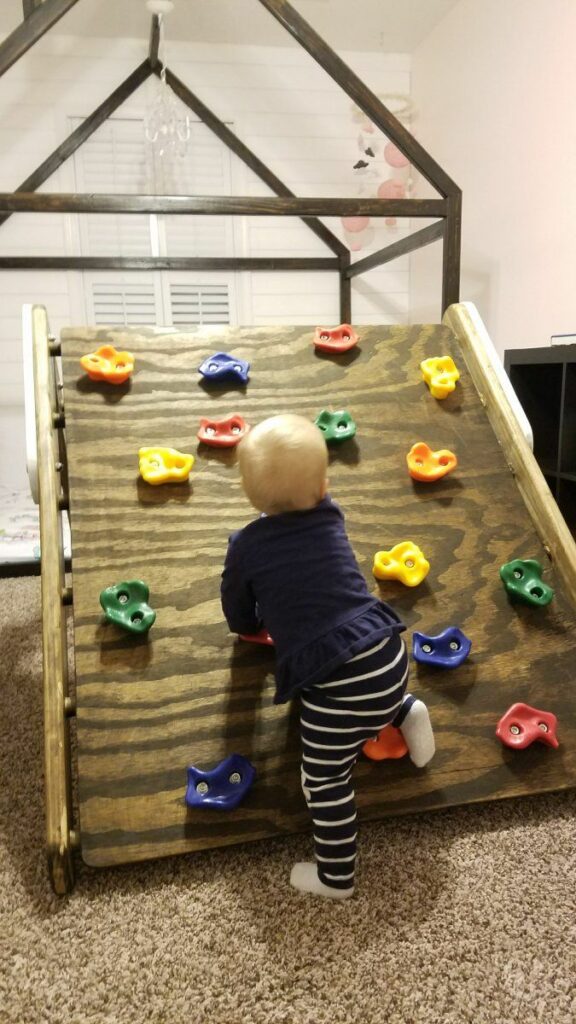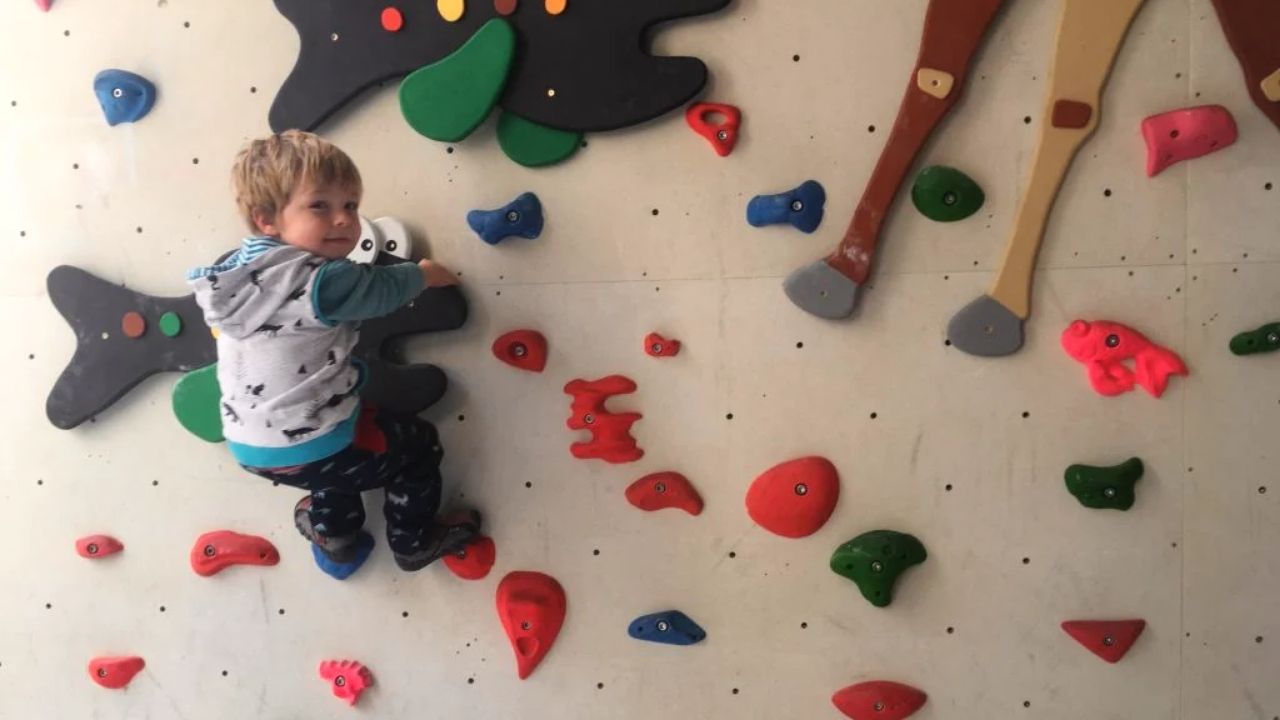We all want our young ones to stay healthy and physically fit. And what’s a more fun way to stay active than regular ol’ exercise? Rock climbing and bouldering sure fit the bill. But are they really safe for our kids and toddlers?
Years ago, I was just as scared about my kid’s safety as you are right now and started considering other ways to build their muscles. But my personal experiences and love for climbing compelled me to give it a try, and I’m glad I did.
Even if you’re not into bouldering but your kid is interested, there’s no harm in trying it out with them. Regardless of your own experience, bouldering is one of the best parent-child adventures you’ll ever have.
Bouldering & Rock Climbing for Kids and Toddlers
Here’s a quick overview for newcomers.
Bouldering is when you climb boulders without any equipment. Rock climbing is when you climb a rock wall or a cliff using equipment such as a harness and belay devices. You can do it either indoors or outdoors.
1. At what age can your kid start climbing?
There’s no certain age for your toddlers and kids to start bouldering or rock climbing. Some kids start climbing at just 2 years old. You could play some games and build their techniques from thereon. Kids between ages 4 and 7 can start working on artificial climbing walls.
Some gyms, however, don’t allow kids under 12, but you don’t really need a gym from the get-go. The idea is to start climbing during their impressionable years, so they learn quickly.
2. How to get your child started, and is it safe?
Bouldering may look tough, but it’s entirely safe for children. Indoor bouldering gyms and artificial walls are the best options to get your child into climbing. Some parents try outdoor climbing, but it’s not particularly safe or necessary at the beginning.
Here are some excellent climbing walls if your toddler is too young for the gym.
3. Climbing Equipment for Children
Climbing equipment for kids is no different than for adults. You’ll need a pair of kids climbing shoes, a kids harness, kid-friendly belay devices, a small helmet, and some chalk that suits their skin.
4. Is climbing expensive for children?
Bouldering and rock climbing for children will involve certain costs for things like equipment, artificial walls, and gym fees. The affordability is up to your budget. Although you don’t need to spend too much and it’s an excellent sport in terms of the cost to reward ratio.
The Golden Rules
I like to throw caution to the wind and have just as much fun as the next guy. But I’d never risk my kid’s safety.
So, before you get them to climb, tell your toddlers and children to follow the rules at all times.
1. Climbing Rules For Toddlers and Kids
A. Your child shouldn’t start a climb without your permission. If they climb below or above anyone else, they could hurt themselves or someone else.
B. They shouldn’t run around. Children are heart-meltingly cute when they’re having fun, but an indoor gym isn’t the place to run around.
C. They shouldn’t touch anyone’s equipment, especially chalk. Most climbers don’t like that.
D. They should always be in their equipment. Have them suit up in their climbing helmets, harness, chalk, and climbing shoes before starting.
E. They shouldn’t yell or scream. Explain why they shouldn’t shout on the climbing floor because it’s annoying for other climbers.
F. They shouldn’t leave your side. Climbing gyms can be dangerous if you don’t know what you’re doing. So make sure your kid or toddler doesn’t leave your site.
G. They shouldn’t go into adult-only (18+) climbing areas.
2. Rules / Tips For You To Follow
You also need to be on your toes at all times, vigilant, and atleast 5 steps ahead. You already know the drill, but these basic reminders may be helpful for the babysitter:
A. Don’t let your kid or toddler out of your sight for safety reasons.
B. Don’t let them into adult climbing areas because they will try to do so.
C. Don’t walk around the walls with your child. Mishaps can happen, and other climbers can fall down.
D. Don’t force climbing on your kid – encourage them to experience it and decide for themselves.
E. Don’t get distracted or indulge in a conversation while spotting for your child.
F. Don’t be afraid of canceling climbing plans if the gym is jam-packed.
G. Don’t let your kids bring food and beverages on the climbing mats.
H. Don’t forget to learn the local gym rules about bouldering and climbing for children.
Benefits of Starting Climbing Early
Getting your kid to climb from an early age is extremely beneficial, especially when they’re in their formative (“programmable”) years. So put the proper habits in while the concrete is still wet, so to speak.
A. Physical Growth
Proper bone formation and steady physical growth are important for every new parent out there. And when encouraging your child to do physical activities, there’s nothing better than rock climbing or bouldering.
It’s the perfect blend of exercise and fun – your children will not only develop their muscles and bones but their brains as well. They’ll become more flexible thanks to the holds on kids climbing walls and sharpen their analytical skills while solving bouldering problems of their level.
B. Social Growth
I mention in my every climbing blog that rock climbing is a social sport. So you shouldn’t do it alone, even if you can. Most of my best climbing experiences involved my climbing buddies, and that’s the same for my little one.
Your children will learn to interact with fellow toddlers and kids and make new friends. Eventually, your climbing sessions will become a supercool playgroup.
C. Boosting Confidence & Preparing Them For Future
I believe that “wins” are necessary for everyone, be it a child or an adult, and rock climbing early is a great way to boost your children’s confidence. And wins are just the byproduct of how earnestly you try – which is the best thing about kids.
Let’s face it, most adults don’t try new things because of fear of failure. But, unlike adults, kids don’t get embarrassed falling down. They’ll laugh it off and start climbing again, boosting their skills, confidence, and analytical mind.
Watch this video by Mark Rober on “Tricking Your Brain Into Learning More” to understand this better.
D. It Doesn’t Get Cuter Than This…

Children Games to Encourage / Practice Climbing
Do you know the most tried and tested way to help children learn? Fun games, of course. Here are some games you could play with your toddlers and kids to encourage them to climb and work on their techniques:
1. Prize: Put a “prize” on one of the holds or at the top and give your kid some conditions to get to the prize – like using specific holds or a limited number of moves. This will develop their puzzle-solving skills.
2. Animals: Divide the climbing wall into three parts, namely air, water, and land. Then shout out the name of an animal, and the kids will have to jump and grab that part of the wall. This will develop their muscles and teach them about animal habitats.
3. Chaos: Make half the kids start from one side and the other half on the opposite. The two teams are supposed to climb and reach the other side before their opponent. Be careful when they meet in the middle and cross the middle line.
5. Can’t See You: To play this game, you’ll be blindfolded and stand on the mat and throw soft bags on the wall. Children are supposed to climb across without getting hit. You’ll want to keep another adult around to monitor.
6. Treasure Hunt: It’s a modified version of “prize,” but this time, the children don’t know which hold has the prize.
This was everything you needed to know about getting your kid to climb early. Visit your local climbing gyms, check out their arrangements, and make your final decision.
Happy climbing!

